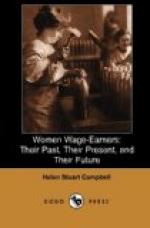The reports from Kansas and Wisconsin give a wage but slightly above that of New Jersey, the weekly average being $5.27. Of the 50,000 women at work in 1889,—the number having now nearly doubled,—but 6,000 were engaged in manufacturing, the larger portion being in domestic service. Save in one or two of the larger towns and cities, there is no overcrowding, and few of the conditions that go with a denser population and sharper competition. Kansas gives large space to general conditions, and, while urging better pay, finds that her working-women are, as a whole, honest, self-respecting, moral members of the community. Factory workers are few in proportion to those in other occupations; and this is true of most of the Western States, where general industries are found rather than manufactures.
The report from Colorado for 1889 includes in its own returns certain facts discovered on investigation in Ohio and Indiana, and matched by some of the same nature in Colorado. The methods of Eastern competition had been adopted, and Commissioner Rice reports:—
“In one of the large cities of Ohio the labor commissioners of that State discovered that shirts were being made for 36 cents a dozen; and that the rules of one establishment paying such wages employing a large number of females, required that the day’s labor should commence and terminate with prayer and thanksgiving.”
In Indiana matters appear even worse. By personal investigation, it was found that the following rates of wages were being paid in manufacturing establishments in Indianapolis: For making shirts, 30 to 60 cents a dozen; overalls, 40 to 60 cents a dozen pairs; pants, 50 cents to $1.25 per dozen pairs. “In our own State,” writes the commissioner, “owing to Eastern competition on the starvation wage plan, are found women and girls working for mere subsistence, though the prices paid here are a shade higher. It is found that shirts are made at 80 cents a dozen, and summer dresses from 25 cents upward.”
Prices are higher here than at almost any other portion of the United States, and thus the wage gives less return. In spite of the general impression that women fare well at this point, the report gives various details which seem to prove abuses of many orders. It made special investigation into the conditions of domestic service, that in hotels and large boarding-houses being found to be full of abuses, though conditions as a whole were favorable. In so new a State there are few manufacturing interests; and the factories investigated are many of them reported as showing an almost criminal disregard of the comfort and interests of the employees. Aside from this, the report indicates much the same general conditions as prevail in other States.




